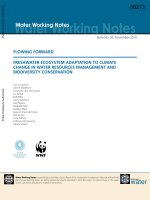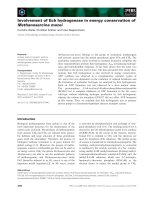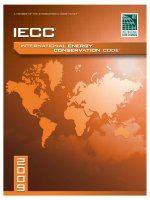Energy Management and Energy Conservation Law
Bạn đang xem bản rút gọn của tài liệu. Xem và tải ngay bản đầy đủ của tài liệu tại đây (2.73 MB, 5 trang )
The Energy Conservation Center, Japan (ECCJ)
Energy Management and Energy
Conservation Law
Establishment :
* 1978 ( after the 2nd oil crisis)
<Roots: Heat-management Association established in 1947>
Purpose of establishment : * Core organization responsible for promotion of
energy conservation
Oct.6.2012
Office location :
Hirokazu Taniguchi
Managing Director
Energy Conservation Center Japan
P 1
Energy Conservation Center Japan
* Tokyo Head office & 8 branches
Supporting member :
* 2,658 companies (as of April 2010)
Staff (full time) :
* 134 persons (as of Nov. 1st, 2011)
Budget (FY 2011) :
* 2,554 million yen (Approx. 32 million US$)
Activities of ECCJ
ECCJ Head Office and 8 Branches
Hokkaido Branch
1. Promotion of Energy Conservation and CO2 Emission
Reduction for Factories, Buildings, Stores, etc.
●
Sapporo
( Located at the same cities
where METI local offices locate. )
●
●
Hokuriku Branch
Sendai
Fukuoka
Tohoku
Branch
T h k B
h
●
●
Kanazawa
Hiroshima
Osaka
Tokyo
Takamatsu
Nagoya
●
Support for CO2 reduction measures
Head Office
●
●
Tokai Branch
●
P 3
Energy Conservation Center Japan
Provision of information on energy efficient
equipment through energy-saving labeling
Promotion of regional energy conservation
practices in local communities
Promotion of energy efficient equipment
through exhibition (ENEX), etc.
4. Promotion of International Cooperation for Energy
Conservation
●
Dispatch of experts
●
Acceptance of trainees from abroad
●
●
Asia Energy Efficiency and
Conservation Collaboration Center
Cooperation with energy conservation
business
5.
5 Implementation of National Examinations,
Examinations etc.
etc
for National Qualification of Energy Manager
National Exam and training for qualified energy
managers
Seminar for “Type 2 Energy Manager”, etc.
3. Support of Capacity Building for Energy
Conservation and Activities
Osaka Branch
Shikoku Branch
Energy conservation audit, instructions,
survey and analysis for factories, buildings,
Provision of information on the Energy
Conservation Act, energy conservation
policies, energy conservation technologies,
2. Information Provision to Disseminate Energy
Efficient Equipment, etc.
Chugoku Branch
Kyushu Branch
P 2
Energy Conservation Center Japan
Capacity Building for energy conservation
through educational seminars, etc.
Support for capacity building for energy
conservation in local communities
Information provision on energy
conservation through publication
Energy Conservation Center Japan
Source: The Energy Conservation Center, Japan
Outline of the EC Law of Japan
1973,1978
Oil crisis <Energy
security>
1979 the Law Concerning the Rational
Use of
Energy (Energy Conservation Law)
enacted
Objective of the EC Law of Japan
contribute to
the sound development of the national economy through
implementing necessary measures for the rational use of energy
in factories, buildings, transportation, and machinery and
equipment, to comprehensively promote the rational use of energy,
while it seeks to ensure the effective utilization of fuel resources that
would meet the economic and social environment of energy
Source: The Energy Conservation Center, Japan
Energy Conservation Center Japan
P 5
Energy Conservation Center Japan
P 6
Scope of Regulations under Energy Conservation Law
Outline of the system of the EC Law
Business operators that conduct business operations
by establishing a manufacturing plant.
Business operators that conduct business operations
by establishing a business location (hospitals, hotels,
schools, etc.).
(1) Manufacturing plants
and business locations
Target of EC
The Standard of
Judgment
The Energy
Conservation
Law
Business operators that provide cargo and passenger
transport services as business.
Cargo owners: Business operators that have their
cargo
g transported
p
by
y transportation
p
service providers.
p
(2) Transportation
(3) Residential buildings
and structures
Business operators that place orders for construction
of residential buildings or structures.
Owners and managers of residential buildings and
structures.
(4) Machinery and appliances
Manufacturers and importers of machinery and
appliances that consume energy.
Companies
( Factories and workplaces )
gy managers
g
Energy
Qualification
Periodic report
Submit
Government
Medium-long term plan
Survey
7
Energy Conservation Center Japan
Organizing Energy
management system
Inspection
P 8
Energy Conservation Center Japan
Steps of Energy Management
EC law in terms of Management
1)Manager and Top Manager’s Role
2)Visualization and Target Setting
3)Activities (Standards of Judgment)
4)Verification of the results
P 9
Energy Conservation Center Japan
Role of Energy Managers
Submission of
‐ Periodical report on energy consumption
‐ Medium‐to‐long term improvement plan
Top Management
Energy Conservation Center Japan
10
Designated Energy Management Factory
Government
Classification
Advising on
‐ Improvement plan of Energy Efficient equipment and facilities
‐ Organization for Energy Efficiency and conservation
Energy Conservation
law
Annual Energy Consumption
Energy Manager
‐ Making the periodical report
‐ Keeping the energy consuming facilities in
sound condition
‐ Carrying out “energy audit”
- Manufacturing
- Mining
- Electricity Supply
- Gas Supply
- Heat Supply
Type 1 Designated
Energy
Management
Factory (A)
- All industries other than
those listed left,
(e.g. office buildings,
department stores, hotels,
schools, hospitals,
government offices, and
amusement parks)
- Head office / office bldg.
of the left listed
industries
Type 1 Designated
Energy
Management
Factory (B)
3,000 kL
Type2 Designated
Energy Management Factory (B)
<Energy Conservation Activities>
‐ Instruction to the employees for energy conservation activities
‐ Technical advice for energy efficient operation of the facilities
Employees
Energy Conservation Center Japan
• Participation of a Qualified Energy
Manager at the time of mid- & long- term
plan preparation
• Submission of Periodical report
(A) Type1 Energy Manager
(B) Type2 Energy Manager
1,500 kL
0 kl
Regulatory obligations
Regulatory obligations
• Appointment of a type1 energy manager
• Preparation and submission of mid- & long- term plans
Energy Manager is a “Key Person” for promoting the E‐C activity.
Regulatory obligations
•Appointment of a type2 energy manager
・ Preparation & Submission of mid- & longterm plans
• Submission of Periodical report
Energy Conservation Center Japan
•Appointment of type2 energy manager
• Submission of Periodical report
Number of Designated Energy
Management Factory
Outline of the test for qualified person
for energy management
March 2009
Buildings
Factories
I. Overall energy management and regulations
Ⅰ.エネルギー総合管理及び法規
Total
1.
Required basic
Type1
5,824
,
1,996
7,820
Type2
3,841
3,042
6,883
Total
9,665
5,038
14,703
必須基礎課目
subjects
電気分野
II. Basics of the flow of heat and
fluid
Ⅱ.熱と流体の流れの基礎
III. Fuel and combustion
Ⅲ.燃料と燃焼
IV.
Heat utilization equipment and
Ⅳ.熱利用設備及びその管理
management thereof
II. Basics of electricity
III. Electrical equipment and
Ⅱ.電気の基礎
appliances
Ⅲ.電気設備及び機器
Ⅳ Electric power
Ⅳ.電力応用
applications
Energy Conservation Center Japan
P 14
Management 2
Visualization of the actual data of energy
Number of certification for
qualified energy managers
Example:
office building
Candidate
Certified
12000
No. of
o person
Electrical field
熱分野
P 13
Energy Conservation Center Japan
Energy situation and policy
1.エネルギー情勢・政策
2. Energy compendium
2.エネルギー概論
3. Basics of energy management technology
3.エネルギー管理技術の基礎
3.
ネルギ 管理技術の基礎
(Understanding
and implementing judgment criteria)
(判断基準の理解・実践について)
○ Laws and ordinances concerning the rational use of energy
4.エネルギーの使用の合理化に関する法律及び命令
Heat field
Optional
選択専門課目
specialized
subjects
14000
試験課目
Test
subject
Classification
区分
13,294
10000
11,719
8000
6000
4000
3,463
2000
0
Survey and analyze energy consumption volume per equipment
1 9 7 9 1 9 8 1 1 9 8 3 1 9 8 5 1 9 8 7 1 9 8 9 1 9 9 1 1 9 9 3 1 9 9 5 1 9 9 7 1 9 9 9 2 0 0 1 2 0 0 3 2 0 0 5 2 0 0 7 2 0 09
P 15
Energy Conservation Center Japan
→ this makes it possible to think reduction volume and countermeasures P 16
Energy Conservation Center Japan
Submission of periodical report
Energy
manager/
Energy
management
officer
Top executive
of company/
factory
Preparation
Report
METI
local
bureau
Submission of medium and long term plan
METI Minister
(Energy Efficiency
and Conservation
Division)
Submission
<Report contents>
Top executive of
company/ factory
Energy
manager
Advice / participation
Plan
Preparation
METI
local
bureau
Submission
METI Minister
(Energy
Efficiency and
Conservation
Division)
* Total energy consumption (kl /year)
* Energy consumption by energy type (list),
(list)
<Plan contents>
* Energy intensity (unit energy consumption)
* Changes of energy intensity for past 5 years
* Production quantity or total floor area of a building, etc. (closely related
to energy consumption)
* Operating conditions of energy-consuming facilities, and the new
installation / dismantling
Energy Conservation Center Japan
* Details of a plan for improvement measures and expected energy
conservation effects
(Installation of high energy efficient facilities/equipment)
* Period (approx. 3~5 years)
* Comparison with the plan submitted in the previous year
Energy Conservation Center Japan
18
Efficiency improvement by Top Runner
Program
Top Runner Program
Fuel
Efficiency
(km/L)
19km/L
18km/L
16km/l
15km/L
12. Space heaters
2. Freight vehicles
13. Gas cooking appliances
3. Air-conditioners
14. Gas water heaters
4.TV sets
15. Oil water heaters
15km/L
5. Video-cassette
recorders
6 Fluorescent lights
6.
Achievement is judged
by weighted average
per product category
12km/L
Target Fiscal Year
At the time of standard setting
Product Category
1. Passenger vehicles
17km/L
14km/L
13km/L
Energy conservation standards according to Top Runner
method
Efficiency
Efficiency
Target
Base
Improvement
Improvement
Fiscal Year Fiscal Year
(initial expectation) (result)
Target products (23 products)
Example of Top Runner Program
7. Copiers
8. Computers
9. Magnetic disc units
10. Electric refrigerators
11. Electric freezers
TV sets (using CRTs)
Video Cassette Recorders
Air Conditioners #
Electric Refrigerators
Electric Freezers
Passenger Vehicles (Gasoline) #
Freight Vehicles (Diesel) #
Vending Machines
Fluorescent Light Equipment #
Copying Machines
Computers #
Magnetic Disc Units #
Electric Toilet Seats
16. Electric toilet seats
17. Vending machines
18. Transformers
19. Electric rice cookers
20. Microwaves
21. DVD recorders
22. Residential router
23.Layer 2 switch
Top Runner Program:
The concept of the program is that fuel economy standards for vehicles and energy conservation
standards for electric appliances, etc. shall be set exactly the same as or higher than the best
standard value of each product item currently available in the market.
P 19
Energy Conservation Center Japan
2003
2003
2004*
2004
2004
2010
2005
2005
2005
2006
2007
2007
2006
Management Items
Contents
1
Target standard (Plan)
such as: air ratio, waste gas
temperature,wall temperature, illuminance
standard, air conditioning system standard
2
Measurement and recording
Regular measurement and record such as:
operational hours, energy consumption,
temperature, etc. of the target facilities and
systems.
3
Maintenance &
Inspection (Check)
Regular check and recording in order to
maintain high efficiency.
4
Maintenance and inspection of
facilities (Action)
Improvement of facilities which are not
sufficient to comply with target value
Energy Conservation Center Japan
21
Overview and Composition of Management Manuals
22
Sample of Management Manual
Management Manuals of Steam Boiler
Reference No.
A1-1
1. Purpose
This management standard is aimed at the rationalization of the use of energy through appropriate implementation of operation
control, measurement recording , maintenance and inspection , and new installation , based on Article 5 and also “Judgment criteria”
of notification No. 65 of the Act concerning the Rational Use of Energy.
xxx Factory, Energy Management Rules
Management rules of energy management systems for factories based on the
Act on the Rational Use of Energy
2. Scope
This standard covers steam boilers (for process use and also as a heat source of air conditioning) installed at this plant.
xxx Facility, Management Manuals
Manuals setting specific management standards for each facility
based on the “Evaluation Criteria”
3. Specifications of the boiler facilities concerned, and number of boilers
- Type: Flue and smoke tube boiler
- Fuel: C heavy oil
- Rated maximum equivalent evaporation: 20 t/h, 2 boilers
- Rated maximum pressure: 1 MPa (gauge pressure),
Normal maximum working pressure: 0.9 MPa (gauge pressure)
xxx Facility
Facility, Operation Procedure Manuals
Management manuals prescribing the energy conservation
operation for specific facilities
xxx Facility, Measurement and Recording Manuals
Item
Control or standard (1)
Management manuals prescribing procedures of measurement
and recording for understanding energy conservation
performance of facilities
xxx Facility, Maintenance and Inspection Manuals
Management manuals prescribing procedures of maintenance
and inspection for maintaining the performance of facilities
Contents
1. Rationalization of fuel combustion
(1) Air ratio
(2) Adjustment of load on multiple boilers
(3) Fuel property
23
Management standard
1.20-1.30
Load distribution control
Sأ1.0% Vuscosity:10sto@50Ԩ
2. Heating facilities
(1) Boiler feed water heating steam pressure
0.1 MPa (gauge pressure)
(2) Process steam supply pressure (normal pressure)
(3) Air conditioning steam main conveying pipe
0.8 MPa (gauge pressure)
pressure
(4) Boiler feed water quality control
Energy Conservation Center Japan
P 20
“Management Manuals” are the manuals specifying the operational method
of facilities and systems which enables a production by energy use as
minimum as possible
(Do)
Facility
B
25.7%
73.6%
67.8%
55.2%
29 6%
29.6%
22.8% (FY2005)
21.7%
37.3%
35.6%
72.5%
80.8%
85.7%
14.6%
Management Manual
The standard of judgment presents a set of guidelines for the individual measures
about the basic matters stated in the basic policy in order to guide business
operators to judge and conduct appropriate and effective implementation of the
rational energy utilization.
Facility
A
16.4%
58.7%
66.1%
30.5%
22 9%
22.9%
22.8%
6.5%
33.9%
16.6%
30.8%
69.2%
71.4%
10.0%
Energy Conservation Center Japan
Management 3:Activity
(Standards of Judgment)
Energy Conservation Center Japan
1997
1997
1997**
1998
1998
1995
1995
2000
1997
1997
2001
2001
2000
Energy Conservation Center Japan
Reference material, etc.
According to boiler operation
procedure
Refer to the criterion for each
production
process.
0.3 MPa (gauge pressure)
According to JIS B8229
24
Management 4
Verification of the results by activities
200
2009
2010
150
100
50
Dec
Total
Oct
Nov
Sep
Jul
Aug
Jun
Apr
May
Mar
Jan
0
Feb
ctric consumption
Elec
(k
kWh/day/room)
Standards and Target Values
the Electric power consumption of a city hotel in 2009 and 2010.
It is easy to understand the drastic improvement in 2010 compare to 2009. In
this hotel ,the energy manager made an energy conservation team to reduce
energy consumption in 2009. After the action, they could reduce 10% electric
consumption.
P 25
Energy Conservation Center Japan
PDCA Cycle is the key to achieve good energy
management
Transition of Energy Consumption
Million Kl in crude oil
equivalent
(百万原油換算kl)
Trillion yen
GDP
GDP
1973‐2006
450
400
600
23.5%
2.3 times
2.3
times
350
P 26
Energy Conservation Center Japan
Transportation sector
500
1973-2006
2.1 times
400
300
16.4%
31.7%
250
/
Commercial/residential sector
18.1%
1973
2006
1973-2006
300
200
2.5 times
200
150
100
44.9%
65.5%
Industrial sector
50
1973‐2006
100
1.0 time
1.0
time
0
0
73 74 75 76 77 78 79 80 81 82 83 84 85 86 87 88 89 90 91 92 93 94 95 96 97 98 99 00 01 02 03 04 05 06
Fiscal Year
(Source) Total Energy Statistics, Annual Report on National Economy.
(Note) It must be noted that the values after 1990 were differently calculated from those of the years before that, because the calculation method for totaling
the total energy statistics was changed in that year.
Energy Conservation Center Japan
Source: METI/General Energy Statistics
P 27
Summary
(1) The EC Law of Japan has been played very important roles to
promote energy efficiency and conservation, and to achieve great
improvement.
(2) The methods of the EC Law are closely related to the management
in the manufacturing factories and the workplaces.
(3) The experience and the method of Japan for energy efficiency and
conservation under the EC Law is a very useful knowledge for the
countries
t i which
hi h need
d and
d require
i th
the iimplementation
l
t ti off
institutional systems to promote energy efficiency and conservation
for their countries.
Thank you
Energy Conservation Center Japan
Merit 1: Reduce
Operational
Cost
Energy Conservation Center Japan
Source:
The Energy Conservation Center, Japan
Merit 2: Improve
Corporate image
28









